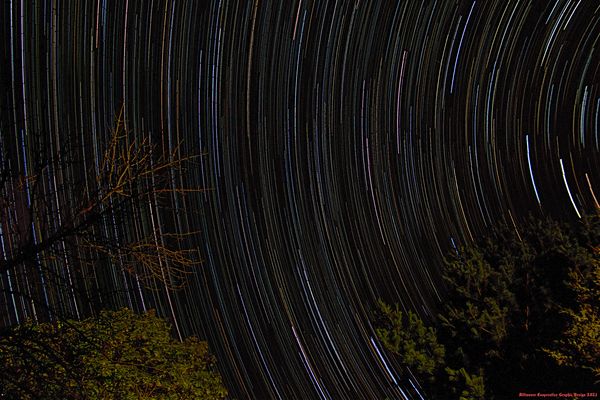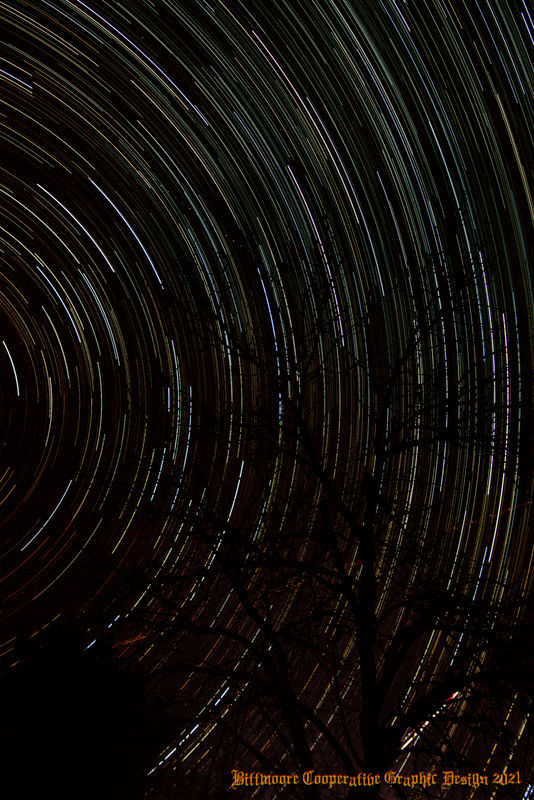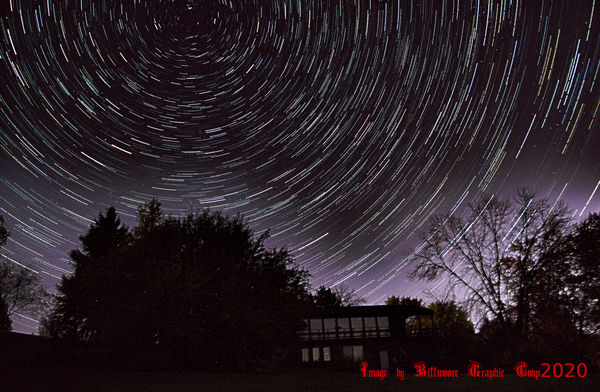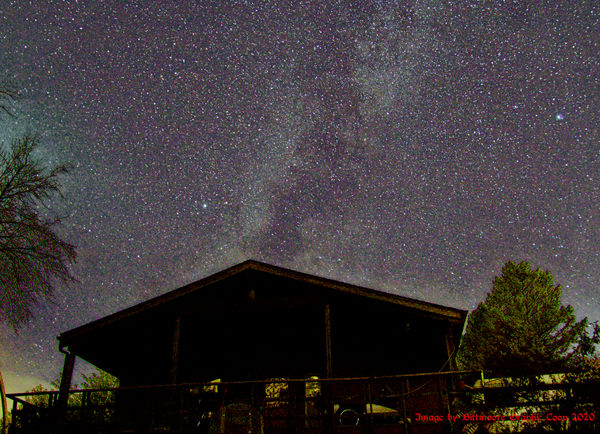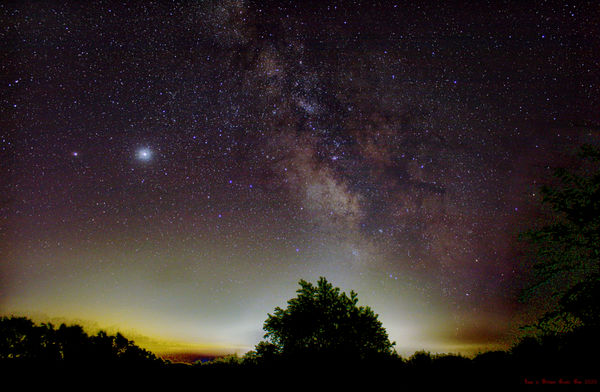Posts for: Bittmoore
Jul 22, 2021 15:53:04 #
BigDale I live on a Bortle 5/6 boundary so I get it, most of my star trails are stacks of 4-13sec subs. Once in a while I just set one camera up knowing I won't be able to stack them for anything but trails while I concentrate on the other camera and target.
This is one of my favorites though it was a long, long, long night in 30sec chunks. I thought I'd post one of my < 30 sec subs stacks but apparently I didn't put any on my phone. 😖
This is one of my favorites though it was a long, long, long night in 30sec chunks. I thought I'd post one of my < 30 sec subs stacks but apparently I didn't put any on my phone. 😖
T4i & Tamron 18-400mm f/3.5-6.3 Di II HLD VC: 527 x 30sec f/5.6 800ISO stacked Sequaror finished in GIMP
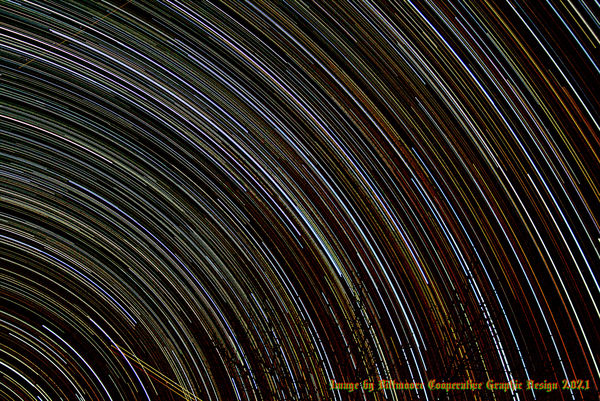
(Download)
Jul 22, 2021 15:29:44 #
SonnyE I thought that was the MW 😂
I need opposing event horizons to keep me centered - I'll never be grounded but ...
I need opposing event horizons to keep me centered - I'll never be grounded but ...
Jul 22, 2021 15:24:42 #
Thanks alberio, they are fun. I even made a preset for backyardEOS since after a couple hours in I was developing a habit of forgetting to activate the shutter and ending up with voids in the trails.
Jul 21, 2021 23:52:58 #
After not being able to get even 5min in on Orion or Andromeda this past season I was feeling kind of bummed knowing I still had a long wait before MW season would arrive so I decided to do something to brighten my - and others - spirits with a bit of bright night lights.
You've always got a rainbow, just gotta know where to look for it.
You've always got a rainbow, just gotta know where to look for it.
Feb 15, 2021 20:42:37 #
What with the skies being mostly cloudy or mainly overcast I decided to take a look back at some previous shoots. Some I'll likely redo in one form or another and some I never did get around to for whatever reason(s) they may have been - I'm gonna say work.
This short stack (10 lights) from Nov 2019 was taken at the wrong ISO (thought I turned it from 1600 to 800 but instead 3200) and found out I'd forgotten to charge the battery shortly after making adjustments.
Stacked in dss 4.2.3
PP in GIMP 2.10.20
Any/All CC welcome
This short stack (10 lights) from Nov 2019 was taken at the wrong ISO (thought I turned it from 1600 to 800 but instead 3200) and found out I'd forgotten to charge the battery shortly after making adjustments.
Stacked in dss 4.2.3
PP in GIMP 2.10.20
Any/All CC welcome
Canon Rebel T6: 13 sec., 3200 ISO; Tamron 18-400mm f/3.5-6.3 Di II VC: 18mm f/3.5
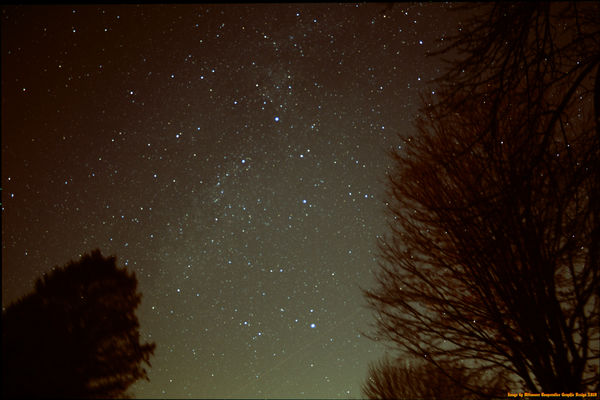
Dec 2, 2020 16:50:49 #
Ballard wrote:
Hi Bittmoore br Using the free stuff is a good way... (show quote)
Very nice images!
I have a number of those software (PIPP,Registax6, Autostakkert, RawTherapee) - as well as darktable - although I haven't delved much into them. Trying to learn one, maybe two, at a time. I'm easy enough to confuse.
I understand about reprocessing as I've gone back and redone things as I learn a new technique or get "substantially" better. I archive the CR2s. I'm talking about the temporary files. In SiriL this means converting the CR2 files (~19MB each) -> TIFF (~35MB each); those files then go to preprocessing (creates whole new files ~35MB each) then stacking (more new files) then debayering (more new files ~105MB each) to registration (even more new files ~105MB each) to output. I have set up folders (lights, darks, bias; I've never taken flats and don't really get "dark flats" as a concept) for SiriL to work in but that's still a lot of working space required.
As I'm using a Canon Rebel T4i and a T6 I have EOS and DPP. I've looked at using EOS but the fact that USB cable lengths say to keep it less than 15', and preferably around 10' or less is better - and the minimum time between images - I haven't done much with it. Also, it only handles one camera and when possible I like to run both on different targets.I'm looking at backyardEOS but am satisfied with my remote shutter release for now. When I get a tracking mount that'll probably change. I'm sure I can get more out of my data once I know how to use the tools.
Image 1: A short stack (15, maybe 20 subs) from a target planning session this past Oct. South end of my lot looking North. PP using Sequator -> GIMP (new to using GIMP for astrophotography so still feeling my way around).
Image 2: Another short stack from a planning session around the same time but in the driveway facing west. Iirc there are about 50 subs. Another Sequator -> GIMP PP.
Image 3: Taken from the deck (visible in #1) facing south this past July. Iirc 125 subs run through Sequator -> GIMP for PP. Clearly would have been much better from the ground but I wouldn't have survived the mosquitoes while setting up. At least on the deck the bats helped some. Once I was set up. 😉
Nov 30, 2020 12:38:29 #
As $$ is nearly as hard to come by as clear skies and good seeing I'm trying out a lot of software starting with free/low cost and working my way up to the steep $$/learning curve offerings.
One thing I've found I'm not overjoyed about is the number files it creates during processing. Starting by converting CR2 (18MB) -> FIT (35MB) and each following step creates a new FIT file none of which are auto deleted, or reused, when moving to the next step in the process.
I'll post an image once I get time to work a set all the way through.
One thing I've found I'm not overjoyed about is the number files it creates during processing. Starting by converting CR2 (18MB) -> FIT (35MB) and each following step creates a new FIT file none of which are auto deleted, or reused, when moving to the next step in the process.
I'll post an image once I get time to work a set all the way through.
Nov 30, 2020 11:39:08 #
Except for one or two nights this last week it's been overcast here for quite a long time so I've continued to check out other software for processing my captures.
Still using DSS majority of the time for the majority of my sessions. Found a few where I preferred Sequator's output.
Recently I started checking out SiriL (IRIS for Linux) for Windows as I never got far trying IRIS and its command line.
Tried searching here but came up with no topics on SiriL so I'm wondering if anyone here has used it and any hints, tips, secrets, ...?
Still using DSS majority of the time for the majority of my sessions. Found a few where I preferred Sequator's output.
Recently I started checking out SiriL (IRIS for Linux) for Windows as I never got far trying IRIS and its command line.
Tried searching here but came up with no topics on SiriL so I'm wondering if anyone here has used it and any hints, tips, secrets, ...?
Nov 15, 2020 04:21:08 #
Thanks again JimH123, I will certainly check out that app. Sounds as though it can be used as a stand alone which is good since PS's monthly subscription and cloud-based delivery are not within my tastes.
I understand the "cheating" way of doing it just trying what's easily available to see what can be produced before settling for the "long way around" methods.
I have also tried using DSS's custom rectangle for selecting sky portions to process and layer together.
For now I'll just keep looking up!
I understand the "cheating" way of doing it just trying what's easily available to see what can be produced before settling for the "long way around" methods.
I have also tried using DSS's custom rectangle for selecting sky portions to process and layer together.
For now I'll just keep looking up!
Nov 14, 2020 14:44:11 #
Sorry, forgot to include image info. Both taken at home approximately 1hr west of Milwaukee (so still plenty too much light polution)
Canon T6; Canon 18-55mm kit lens; 18mm-f4-15sec-1600; ~75 subs processed in Sequator
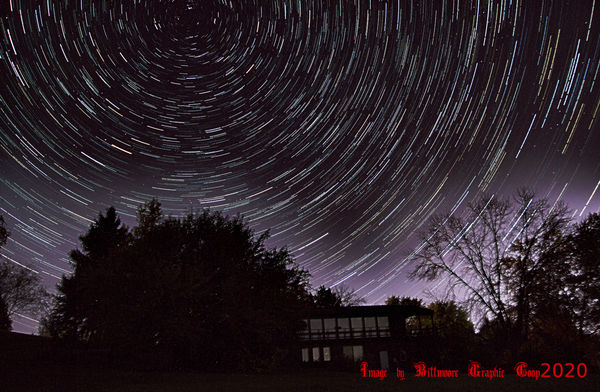
Canon T6; Canon 18-55mm kit lens;18mm-f4-5sec-1600; 6 subs processed in Sequator
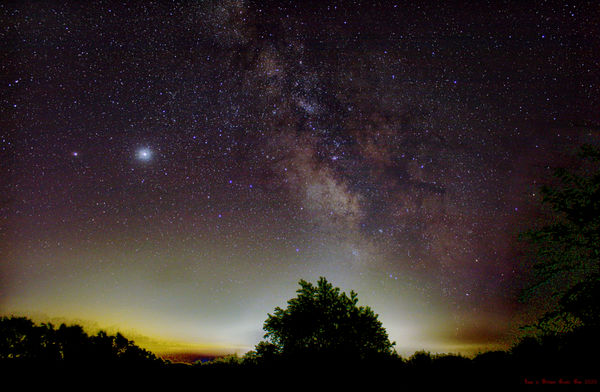
Nov 14, 2020 14:29:45 #
Thanks JimH123.
Yes, GIMP supports layers. I was just curious whether there might be some better methods of utilizing Sequator's abilities. I well know I need more experience using GIMP for astroscapes.
Haven't had many clear nights with good seeing lately so I've been going back through some of my planning captures (identifying better/best site locations, direction, objects/landmarks for inclusion, ...) to see what I can actually get out of them and all the Sequestor processed astroscape images have a pronounced banding along the land/sky boundary.
As I don't have and have never used PS trying to watch PS-centric how-to videos has not been overly beneficial.
Here's a couple examples:
Yes, GIMP supports layers. I was just curious whether there might be some better methods of utilizing Sequator's abilities. I well know I need more experience using GIMP for astroscapes.
Haven't had many clear nights with good seeing lately so I've been going back through some of my planning captures (identifying better/best site locations, direction, objects/landmarks for inclusion, ...) to see what I can actually get out of them and all the Sequestor processed astroscape images have a pronounced banding along the land/sky boundary.
As I don't have and have never used PS trying to watch PS-centric how-to videos has not been overly beneficial.
Here's a couple examples:
This is from a planning session this past July set up at the south end of my backyard in preparation of some much longer sessions this winter.
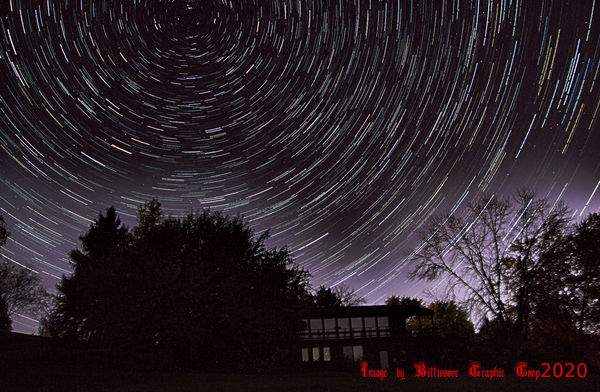
Using layers in GIMP I was able to negate much of the banding except around the top of the center trees in this southernly view from my porch (visible in above picture). Too many mosquitos that night to set up down on the ground.
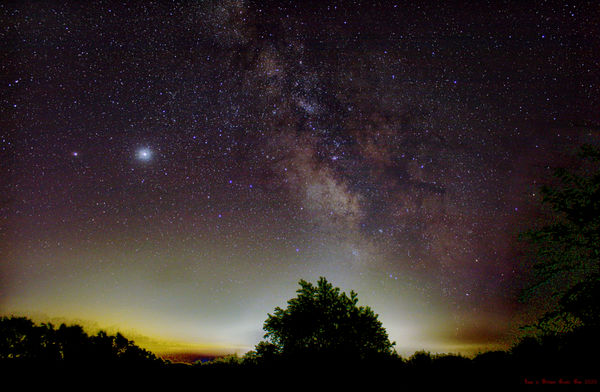
Nov 13, 2020 11:26:04 #
Thanks Marc.
I've been using Sequator for a couple years now off and on. I first tried it out after being disappointed that DSS didn't have a way to process astroscapes without making a mess of the land part of the image. And I understood trying to spoonfeed those types of shots into DSS were never really in the wheelhouse of a program intended for DEEP sky objects. I've had mixed results with Sequator and astroscape images overall. It works pretty well with wide angle starscapes but DSS typically does much better due to the changable parameters.
I may yet need to learn AutoStakkert!
Thanks for replying.
I've been using Sequator for a couple years now off and on. I first tried it out after being disappointed that DSS didn't have a way to process astroscapes without making a mess of the land part of the image. And I understood trying to spoonfeed those types of shots into DSS were never really in the wheelhouse of a program intended for DEEP sky objects. I've had mixed results with Sequator and astroscape images overall. It works pretty well with wide angle starscapes but DSS typically does much better due to the changable parameters.
I may yet need to learn AutoStakkert!
Thanks for replying.
Nov 12, 2020 21:47:42 #
I know I'm out on the fringe as I'm not a Photoshop fan, am still feeling my way around PP astrophotos in GIMP and I only found two posts about Sequator here but I'm hoping maybe somebody knows the answer(s).
I've found that most people tend to prefer astroscapes to wide angle starscapes but in trying to use Sequator to freeze the ground using the irregular mask but there always seems to be a bright "glow" around the boundry area and through the ground area.
Any ideas how to minimize it? How best to "fix" it?
I've tried importing the saved mask file into GIMP and more accurately make the mask as I have access to much smaller size brushes. This seems to help with stars between branches but not much difference in the "glow" issue.
I've found that most people tend to prefer astroscapes to wide angle starscapes but in trying to use Sequator to freeze the ground using the irregular mask but there always seems to be a bright "glow" around the boundry area and through the ground area.
Any ideas how to minimize it? How best to "fix" it?
I've tried importing the saved mask file into GIMP and more accurately make the mask as I have access to much smaller size brushes. This seems to help with stars between branches but not much difference in the "glow" issue.
Nov 12, 2020 21:24:36 #
Sequator really prefers RAW files but, iirc, can also work with BMP & JPG files. Not sure about TIF compatibility other than as an output type.
Mar 6, 2020 14:21:14 #
So I've been working my way through the forum so that I might ask as few dumb questions as possible (for me) as I've long loved astrophotography/astroscapes and am trying to become passable if not better.
As I don't see any follow-up/answer I thought I'd add my 2¢ worth of experience. Every so often I've forgotten to turn off the vibration control (VC) or image stabilization (IS) when going from handheld usage to tripod. Had me ready to toss my Tamron 18mm-400mm f3.5-6.3 Di II VC HLD lens within the first month.
As I don't see any follow-up/answer I thought I'd add my 2¢ worth of experience. Every so often I've forgotten to turn off the vibration control (VC) or image stabilization (IS) when going from handheld usage to tripod. Had me ready to toss my Tamron 18mm-400mm f3.5-6.3 Di II VC HLD lens within the first month.
